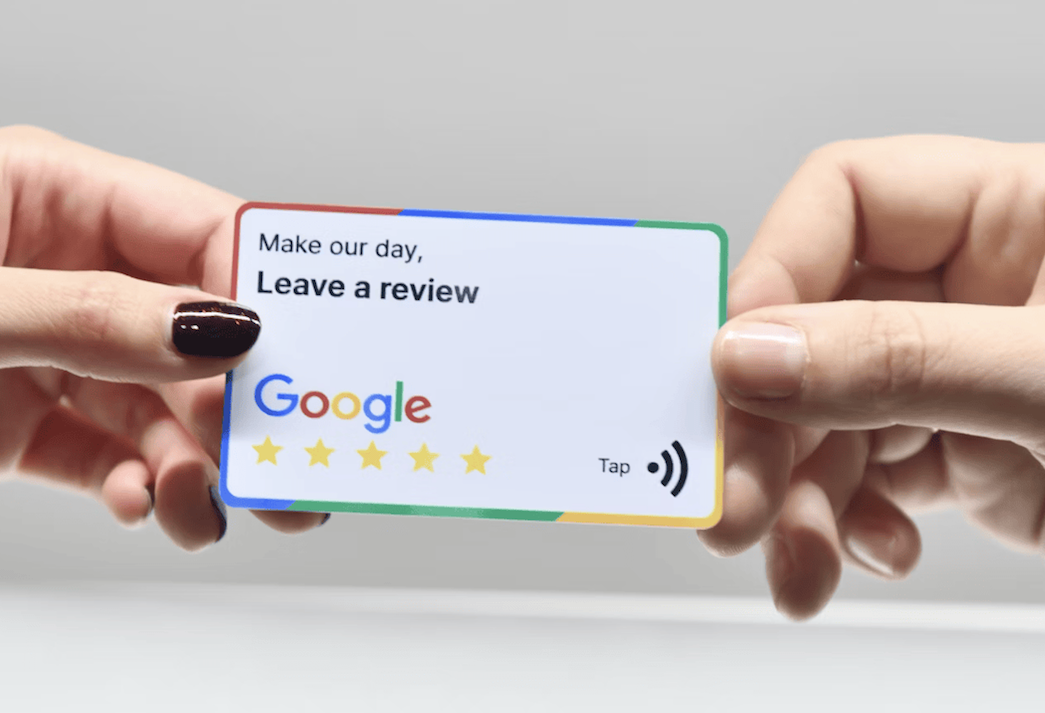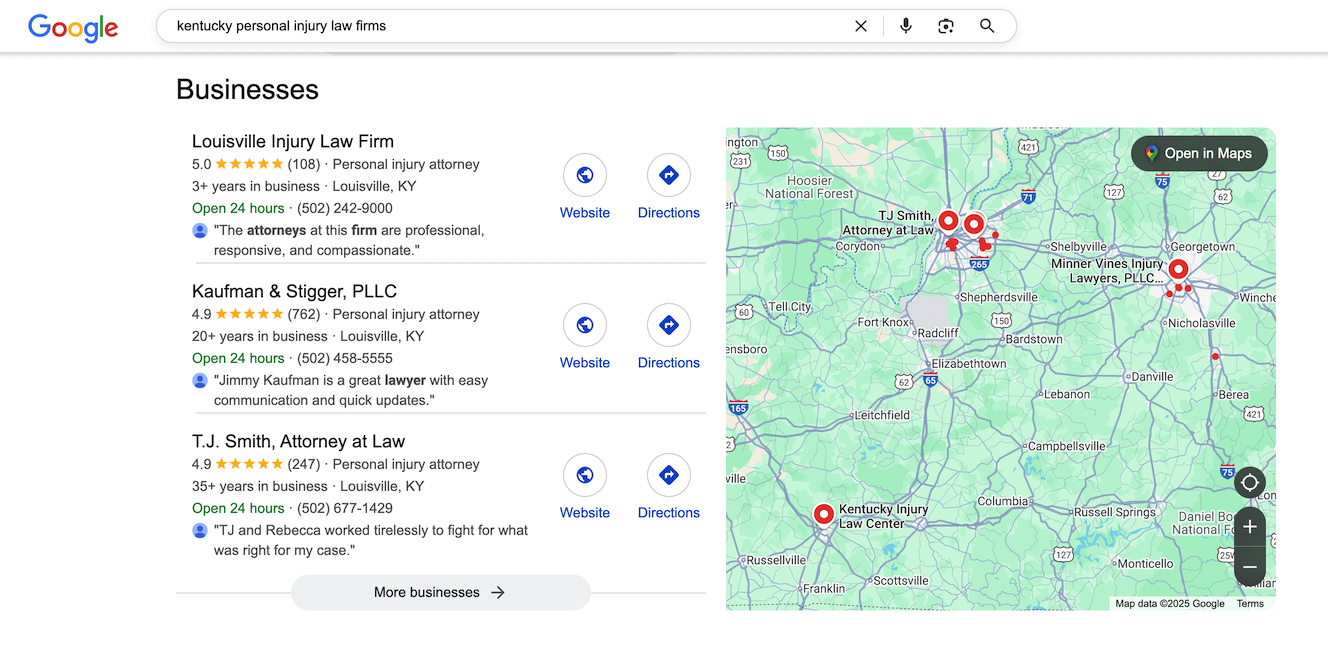
How to Get More Google Reviews For Your Law Firm
Getting Google reviews can be a struggle for many law firms. Even well-established practices often have ten or fewer reviews, which can hinder your credibility and local SEO performance.
A lack of Google reviews actually hurts your firm’s visibility in the search results, meaning your competitors with more reviews will continue to have the edge in local map packs.
Fortunately, there’s an easier way to get more Google reviews — without relying on automated software or bothering grieving clients for testimonials. Read on to learn how.
Why Google Reviews Matter More Than You Think
Google reviews directly influence how law firms appear in local search results. While Google doesn’t publicly share the exact weighting of its algorithm, SEOs agree that review signals are a top-three ranking factor for local searches.
Having lots of recent (and good) reviews drastically increases your chances of appearing in a “local 3-pack” — also known as a local map pack or just local pack. The businesses listed here will always have lots of recent 5-star reviews.

These 3-packs appear in 93% of local searches on Google.
More importantly, 44% of people click one of these three links when they appear in the search results. Businesses listed here receive 126% more traffic and 93% more conversion-related actions (clicks, calls, questions), compared to competitors who aren’t listed in a 3-pack.
In addition to boosting your law firm’s visibility on local searches, getting more Google reviews also sends trust signals to prospective clients.
Put yourself in their shoes. If you’re searching for something important, like a personal injury attorney, are you going to feel better about the firm with six reviews or the one with 60 reviews?
Google’s algorithm favors businesses that demonstrate ongoing client satisfaction with fresh reviews. This ultimately creates a positive feedback loop where visibility increases lead generation, which leads to more reviews, and more leads.
Expanding Your Review Request Strategy Beyond Clients
This is an area where most law firms get stuck. Yes, client reviews are obviously valuable. But they shouldn’t be your only source.
In many practice areas, especially those dealing with sensitive matters (like personal injury, family law, or estate planning), asking clients for reviews can be inappropriate or ineffective.
For example, if you’re representing families in a wrongful death lawsuit or mesothelioma claim, asking them to leave reviews while they’re grieving the loss of a loved one definitely doesn’t feel professional or appropriate.
Instead, your law firm can get reviews from:
- Colleagues and other attorneys you’ve worked with.
- Anyone who’s heard you speak during a conference, webinar, or professional event.
- Referral sources from professionals who regularly send business to your practice.
- Podcast listeners who’ve heard your legal advice.
- People who received a free consultation from your firm (even if they didn’t become a client).
None of this is against Google’s policies, either.
Anyone who has interacted with your business can leave a Google review, even if they’re not a paying customer. As long as the review describes a genuine first-hand experience with you or your firm, then the review is perfectly acceptable.
Why You Should Avoid Review Software (and What to Do Instead)
There are lots of different tools on the market to automate online reviews. Solutions like BirdEye, Podium, or NiceJob may work fine for restaurants and consumer ecommerce brands, but they’re generally not a good fit for professional services like law firms.
I’ve always found that a manual approach works much better for lawyers.
First and foremost, automated review requests typically lack a personal touch, which likely goes against how your law firm wants to be perceived. Generic email or text blasts requesting a review from your client list just doesn’t quite feel right coming from a reputable practice.
It’s also possible that these automated systems could inadvertently create a situation where your solicitations could violate state bar advertising rules. This is a bit of a grey area (and I’m not going to give legal advice to attorneys), but it’s definitely something that needs to be taken into consideration — especially if you’re sharing client data with third parties.
While you’re less likely to get hundreds of reviews very quickly by going with manual outreach, the quality of your reviews will be much better, and your success rate should be higher.
4 Easy Steps for Law Firms to Get More Google Reviews
Here’s a practical four-step approach that any law practice can use to get more reviews on Google. It won’t take up much of your time, you won’t be spamming your clients, and you don’t need any automated software, either.
When implemented properly, it will have an immediate impact on how Google ranks your law firm in local searches and makes it easier for prospective clients to trust you.
Step 1 – Build a List of Potential Review Candidates
Open up a blank document, spreadsheet, or even a piece of paper if you prefer. Start brainstorming a comprehensive list of anyone who’s had a positive professional interaction with you or your law firm.
Forget about clients right now — think broader.
If you’re having trouble, then start looking through your email history, text messages, business cards from networking events, LinkedIn connections, and people in your Rolodex. Take a look back at your calendar to help jog your memory about a conference you’ve attended.
Beyond names, put notes next to each person with their contact info (so you don’t have to look it up again later), relationship, date of last interaction, and any specific details about the engagement that you can remember.
Shoot for at least 25 candidates in this first round. More is better, and closer to 50 would be ideal because the list will get trimmed down before you start your outreach.
Step 2 – Prioritize Your Outreach List
Now you’re going to go through your initial list and identify where to begin. Here’s what you should prioritize:
- Recent engagements (within the last 6 months).
- People who are most likely to respond.
- Anyone you have a strong relationship with.
That’s it.
Don’t overcomplicate this and try to come up with a scoring system or anything that wastes your time. You should be able to look at a name and know if they fall into one of these three categories.
Sending an email to someone you exchanged business cards with two years ago shouldn’t be your starting point, and those types of people can probably be removed from your list altogether.
But someone you worked closely with for ten years should still be prioritized, even if it’s been a year since you’ve last spoke.
Step 3 – Draft a Compelling Review Request
Set aside 20-30 minutes to send five emails.
Don’t use a copy/paste template (people can see right through that). Each message should follow the same general flow, but you can tailor the tone based on your relationship with the person.
Keep it relatively short and avoid generic “hope all is well” openings. Be direct, polite, but transparent about what you’re asking for. Something like this:
Hi [Name],
I’m reaching out because [reference to your last interaction/relationship].
I’m working to build our firm’s online presence, and hoping you’d be willing to share your experience working with [me/firm name] on Google. Your perspective on [something specific – like responsiveness, expertise, professionalism] would be a huge value.
No pressure. But if you’re willing, it will just take a couple of minutes: [insert Google review link].
Thanks for the consideration, and hope to connect again soon.
[Signature]
Consider the timing of this message. Don’t email people over the holidays or try to contact an accountant in the first week of April.
Do whatever you can to increase your chances of this message not only being seen, but the person acting on your request ASAP.
Step 4 – Create a Follow-Up System
Keep a record of everyone you’ve reached out to. I personally prefer using a spreadsheet for this, and you can use the same sheet from your initial brainstorm list back in the first step.
Include the date you reached out and the method (not necessary if they’re all going out via email).
In my experience, most people who are willing to leave a review are going to reply saying it’s done or they’re on it. If they do, add those replies to your notes as well. Don’t assume it’s completed until you see the review posted on your Google Business Profile.
7-10 days after your initial email, you can send a gentle nudge to anyone who hasn’t replied or left a review.
Even something quick like “Hey, just sending a reminder to make sure this didn’t slip through the cracks. Thanks so much!” can go a long way.
Depending on who the person is and your relationship, you could potentially send a third nudge another couple of weeks down the road. You can make the executive decision here because you don’t want to be a pest. If you email someone twice, you could potentially send them a text (some people may have new jobs and not have access to an old email).
Tips and Best Practices
As you’re going through this four-step process, keep the following tips in mind to increase your chances of getting more reviews:
- Make it as easy as possible for people to write a review.
- Set a realistic goal of how many reviews you want to get (even if it’s just a few per month).
- Be consistent with your outreach efforts, and hold yourself to sending at least 5 messages per week.
- Don’t be discouraged and abandon this strategy if you don’t get lots of reviews right away.
- Add a Google Review link and CTA to your email signature, so anyone you contact can leave your firm a review (even people who aren’t part of your outreach efforts).
- Encourage partners and other employees at your firm to take these steps to help scale your outreach.
- Always respond to reviews (both positive and negative) to show Google and prospects that you’re engaged.
If you’ve sent 50 outreach messages and still haven’t got any new reviews over 6 weeks, then something is wrong and you need to go back to the drawing board. It’s highly unlikely that this will happen, but you’ll need to re-evaluate either who’s on your list or how you’re sending these messages.
How Many Google Reviews Are Enough?
There’s no magic number as to how many Google reviews will get you ranked in local searches. But prioritizing quality over quantity will actually help you climb the rankings faster.
Google’s algorithm favors businesses that consistently receive fresh and positive reviews compared to companies with lots of old reviews.
Recency and velocity are more important than total volume. So even getting just five or ten new reviews can make a huge difference.
Final Thoughts
The importance of getting Google reviews for your law practice can’t be overstated. Without them, you’ll have a tough time getting organic leads from local searches.
Asking dead or dying clients to leave you a review obviously isn’t a good idea. But you don’t have to do that or bug their families either.
Just expand your reach to target anyone who’s had a positive interaction with your firm, and things get much easier. You’ll need to spend a little time on outreach, but the influx of new reviews will be well worth it.
